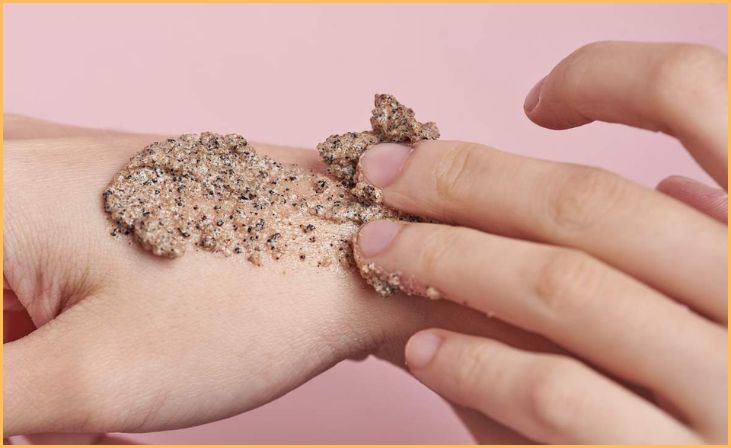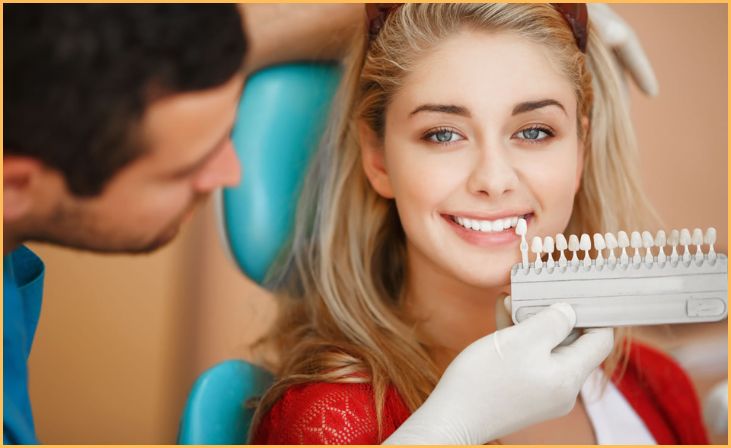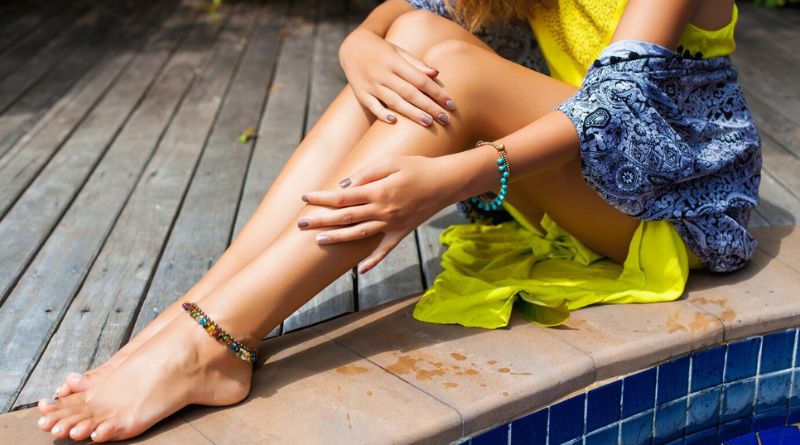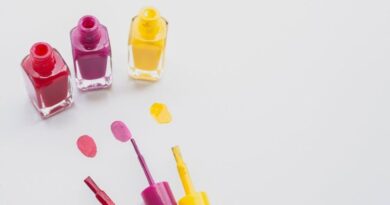Tanned feet, while reminiscent of sunny days, can sometimes result in uneven skin tone or tan lines that may not align with your desired look. Fear not! We unveil effective and gentle methods to bid adieu to those persistent tanning marks on your feet. Whether it’s sandal season or you simply desire an even skin tone, these tips and tricks will help restore your feet to their natural color.
Exposure to the sun or uneven application of sunscreen can lead to darker patches or lines on your feet. This guide aims to equip you with practical remedies and natural treatments to remedy this issue. From simple home remedies using ingredients from your kitchen to specialized products, we explore various approaches to tackle tanning and bring back your feet’s natural radiance.
Ways to Remove Tanning from Your Feet
Exfoliating scrub

An exfoliating scrub is a skincare essential designed to gently remove dead skin cells, unveiling a smoother and more radiant complexion. Formulated with fine granules like sugar, salt, or microbeads, combined with nourishing ingredients such as oils or moisturizers, these scrubs work to slough away dull skin, unclog pores, and promote skin renewal.
Ideal for both face and body, exfoliating scrubs offer various benefits, from improving skin texture and tone to enhancing the effectiveness of skincare products. Regular use can reveal fresher, softer skin and help with issues like rough patches or uneven skin tone.
Applying the scrub in gentle circular motions buffs away impurities, leaving the skin rejuvenated and glowing. However, it’s essential to use exfoliants moderately to avoid irritation, ensuring a brighter, smoother complexion for healthy-looking skin.
Lemon juice and sugar paste
Lemon juice and sugar paste create a natural and effective homemade exfoliant. This DIY blend combines the acidic properties of lemon juice with the abrasive texture of sugar to gently slough off dead skin cells, revealing a smoother complexion.
Simple to make, it involves mixing fresh lemon juice with granulated sugar to form a paste. Lemon juice, rich in citric acid, acts as a natural exfoliant and brightens the skin, while sugar granules work to scrub away impurities.
Applied in gentle circular motions on damp skin, this paste revitalizes and brightens the complexion. However, due to lemon’s acidity, it’s crucial to perform a patch test and avoid sun exposure after application to prevent skin irritation. Incorporating this natural exfoliant into a skincare routine can help achieve a refreshed and radiant glow.
Also Read: 8 Summer Sandals for Hot Days
Baking soda and water solution
A baking soda and water solution is a simple and versatile homemade remedy for various household and personal care needs. Mixing baking soda with water creates an alkaline solution that can be used for multiple purposes.
As a mild abrasive, this solution can effectively clean surfaces, remove stains, and deodorize items around the house. In personal care, it can act as a gentle exfoliant for the skin, helping to remove dead cells and impurities.
Applying this solution topically on the skin requires caution due to its alkaline nature, as it might disrupt the skin’s natural pH balance. It’s recommended to perform a patch test and use it sparingly. Always rinse thoroughly after use to avoid any residue. Overall, this simple mixture serves as a versatile and cost-effective solution for various cleaning and skincare needs.
Hydrogen peroxide soak
A hydrogen peroxide soak is a simple and versatile solution known for its antiseptic and cleansing properties. Diluted hydrogen peroxide, typically used in a solution of 3%, can be employed for various purposes.
In skincare, a diluted hydrogen peroxide soak can be used to cleanse minor cuts, scrapes, or as a mouthwash for oral hygiene. It’s also employed in foot soaks to address fungal infections or soften calluses.
However, caution is crucial as higher concentrations or prolonged use can cause skin irritation. It’s essential to dilute hydrogen peroxide adequately before use and perform a patch test, especially on sensitive skin. Always follow usage instructions and consult a healthcare professional for proper guidance on its application. When used cautiously, a hydrogen peroxide soak can serve as a simple and effective aid for personal care and minor first aid needs.
Whitening toothpaste application

Whitening toothpaste application involves using specialized toothpaste to brighten teeth and remove surface stains. These toothpastes typically contain mild abrasives or chemical agents like hydrogen peroxide to break down stains.
Applying whitening toothpaste is similar to regular toothpaste use: place a pea-sized amount onto a toothbrush and brush teeth thoroughly for about two minutes. Gentle circular motions ensure even coverage.
It’s crucial to follow the recommended usage frequency, as excessive use may cause tooth sensitivity or enamel erosion. Whitening toothpaste typically takes several weeks to show noticeable results, and effectiveness varies among individuals. Consistency in usage and avoiding stain-causing substances like coffee or tobacco can enhance results.
Aloe vera gel massage
An aloe vera gel massage is a soothing and beneficial technique that harnesses the healing properties of aloe vera. Known for its hydrating, anti-inflammatory, and cooling effects, aloe vera gel is used to massage the skin gently.
Obtained from the aloe vera plant, the gel is rich in vitamins, enzymes, and antioxidants that promote skin health. Applying it through a gentle massage helps moisturize the skin, reduce inflammation, and alleviate irritation or sunburn.
To perform the massage, apply a small amount of aloe vera gel onto the skin and massage in circular motions. This can be especially beneficial for dry or sensitive skin areas. Regular use can help rejuvenate the skin, leaving it feeling refreshed and nourished. Always ensure you’re not allergic to aloe vera before applying it extensively.
Milk and honey foot bath
A milk and honey foot bath is a pampering and nourishing treatment that rejuvenates tired feet. Mixing warm water with milk and honey creates a soothing soak known for its moisturizing and exfoliating properties.
The lactic acid in milk acts as a gentle exfoliant, softening rough skin and removing dead cells. Honey, a natural humectant, locks in moisture while offering antibacterial benefits.
To prepare the foot bath, blend warm water with a cup of milk and a few tablespoons of honey in a basin. Soak feet for 15-20 minutes, allowing the mixture to work its magic.
After the soak, gently dry feet and apply moisturizer for added hydration. This luxurious foot bath helps soften skin, soothe tired feet, and promote relaxation, making it an ideal DIY spa treatment for self-care and pampering sessions.
Vinegar and water soak
A vinegar and water soak is a versatile and natural remedy used for various purposes. Combining vinegar, typically apple cider or white vinegar, with water creates a solution known for its cleansing and antibacterial properties.
This soak can be used for various applications, including as a foot soak to soothe tired feet, reduce foot odor, or help with fungal infections. Additionally, it’s utilized as a natural household cleaner due to its disinfectant qualities.
To prepare the soak, mix equal parts water and vinegar in a basin or container. Soak feet for about 10-15 minutes, allowing the solution to work its magic.
It’s essential to dilute vinegar adequately to prevent skin irritation. Always perform a patch test and consult a healthcare professional for specific applications. This simple soak offers a natural and effective solution for various household and personal care needs.
Cucumber slice rub
A cucumber slice rub is a refreshing and revitalizing skincare technique that harnesses the cooling and hydrating properties of cucumbers. Cucumbers, abundant in water content and antioxidants, are known to soothe and rejuvenate the skin.
To perform the rub, simply take fresh cucumber slices and gently massage them onto the skin in circular motions. This technique helps hydrate the skin, reduce puffiness, and soothe irritation or sunburn.
Rich in vitamins and minerals, cucumber slices also aid in brightening the complexion and tightening pores. For an extra cooling effect, refrigerate the cucumber slices before use.
This natural remedy is gentle and suitable for most skin types, making it a quick and easy way to revitalize and refresh the skin, leaving it feeling hydrated, calm, and invigorated.
Coconut oil and turmeric paste

A coconut oil and turmeric paste is a natural and potent remedy celebrated for its myriad of skincare benefits. Turmeric, renowned for its anti-inflammatory and antioxidant properties, when combined with coconut oil, creates a powerful paste that can revitalize and nourish the skin.
To prepare this paste, mix turmeric powder with coconut oil to form a smooth consistency. Apply a thin layer onto the skin, avoiding sensitive areas, and let it sit for 10-15 minutes before rinsing with warm water.
This paste is famed for its ability to brighten the complexion, reduce redness, and address skin concerns like acne or dryness. However, turmeric can stain, so perform a patch test and be cautious with fabric contact. Incorporating this natural paste into a skincare routine may help achieve a radiant and healthy-looking complexion.
Also Read: 09 Size-Inclusive Swimwear for All Bodies
Conclusion
Reviving your feet’s natural tone is achievable with the right techniques and treatments. Bid farewell to tan lines and uneven tanning by implementing these tried-and-tested methods. From natural remedies like lemon juice to store-bought exfoliants, the journey to reclaiming even-toned feet is within reach.
Consistency is key. Incorporate these methods into your skincare routine and observe gradual but noticeable improvements. Remember to moisturize your feet adequately after treatments to maintain suppleness and prevent further tanning issues.
With these effective ways to remove tanning from your feet, step forward confidently, whether it’s barefoot on the sand or slipping into your favorite sandals. Embrace the journey towards achieving evenly toned and radiant feet, perfectly complementing your summer look.
FAQs
Lemon juice, a natural bleaching agent, can help. Apply lemon juice on affected areas, leave for 15 mins, then rinse. Moisturize afterward for nourishment. Additionally, a paste made from yogurt and turmeric can also aid in reducing tan lines when applied regularly.
Look for exfoliating scrubs with ingredients like glycolic acid or lactic acid. These help in gently removing dead skin cells and tan buildup. Consider creams or lotions containing kojic acid or vitamin C for gradual fading of tan marks.
Yes, a mixture of baking soda and water or apple cider vinegar and water can be effective. Soak your feet for 15-20 mins, then gently scrub for best results. Adding a few drops of essential oils like lavender or tea tree oil can enhance the soothing effects.







